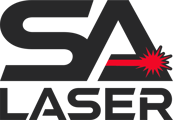Step-by-Step Guide to Calibrate Steps Per Rotation for Rotary Attachments in LightBurn
This guide explains the process of setting up and calibrating the steps per rotation for a rotary attachment in Lightburn for CO2 lasers. Accurate steps per rotation settings are essential for precise rotary engraving.
Step 1: Rotary Setup and Alignment
-
Lower the Work Bed
- Use the Z button with the down arrow on the wireless remote or the Ruida keypad to lower the work bed all the way down.
-
Place the Rotary
- Position the rotary on the work bed with the chuck on the left side and the support cone on the right side.
-
Move the Laser Head
- Use the X and Y movement keys on the wireless remote or Ruida keypad to move the laser head to the top of the central shaft by the chuck. Verify the position using the red dot.
-
Align the Support Cone
- Move the laser to the top of the central shaft holding the support cone. Pivot the cone side of the rotary as needed to align it under the red dot.
- Do not use the Y-axis movement keys to align the support cone side to avoid misalignment.
- Double-check the alignment on the chuck side by moving the rotary, not the Y-axis.
-
Enable Rotary in Lightburn
- Return to Lightburn and click the Rotary Setup button at the top of the screen.
- Select the Chuck radio button and enable the rotary slider (green when enabled).
- Ensure the mirror output slider is off (maroon colored) and select the Y-axis radio button.
- Set the steps per rotation to the default value of 10,000.
- Measure the diameter or circumference of your workpiece using a caliper or measuring tape and enter the value into the corresponding text box.
- Click OK.
-
Connect the Rotary Cable
- Plug the rotary cable into the rotary input located inside the machine on the right side. Ensure the notches are aligned and secure the cable by tightening the washer nut.
- Flip the switch on the right side of the machine towards the rotary option.
Step 2: Load Your Test Piece
- Insert the Chuck Key
- Insert the chuck key into the square holes in the rotary chuck and adjust the jaws as needed to secure your test piece.
- Press the object against the vertical stops of the jaws and tighten the grip on your workpiece.
Step 3: Draw a Rectangle
- Create a Rectangle in Lightburn
- Left-click the rectangle tool and draw a small rectangle in the workspace. Size the rectangle to be 2 inches high and 0.5 inches wide. This rectangle can be on any layer color but should not be on a tool line.
Step 4: Set Focus, Origin, and Settings
-
Set the Focus
- Set the focus for your test piece. Once focused, remove the cone from the lens tube to reduce the chance of collision with the rotary.
- A collision can cause issues with the nozzle, lens, and belt drive.
-
Set the Origin
- Choose User Origin from the start from drop-down menu. Set the job origin to the top left corner.
- Spin the rotary using the Y-axis buttons to the top left position of the tape and press the origin button on the wireless remote or the Ruida keypad.
- Set the rectangle's layer to line mode and adjust the settings to quickly cut through the tape (300 mm/second and 15-20% power is usually sufficient).
Step 5: Frame and Engrave
-
Frame the Graphic
- Rotate the rotary one direction until it stops, then rotate it in the opposite direction at least one full rotation to ensure complete engraving.
- Click Frame to ensure the graphic is the right size and positioned correctly.
- Turn on the exhaust and press Start to begin the rotary engraving.
-
Measure and Adjust
- After the rectangle is cut out, peel it off the test piece and measure the height.
- Divide the measured value by the requested value (2 inches). Take the steps per rotation (10,000) and divide it by this result to get the rotary's steps per rotation.
- Left-click the rotary setup icon and enter this value into the steps per rotation text box and then click OK.
Step 6: Test Your Rotation
-
Adjust Rectangle Height
- Change the height of your rectangle in Lightburn to equal the circumference of your test piece.
- Set your origin at the mark you made on the tape and set your job origin to the top left.
- Click Frame and watch how far the rotary spins. The goal is for it to spin a full revolution and stop at the same mark that you started framing at.
-
Fine-Tune Settings
- If it stops short or long of the mark, manually edit the steps per rotation in the rotary setup window by making small changes to the current value and reframing the rectangle.
- Once you can complete a full revolution without landing short or long of the mark, your steps per rotation are correct. Save this number for future reference.
Conclusion
By following these steps, you can set up and calibrate the steps per rotation for your rotary attachment in Lightburn for CO2 lasers. Proper calibration ensures accurate and efficient rotary engraving. For further assistance, refer to Lightburn documentation or support channels. Happy engraving!
